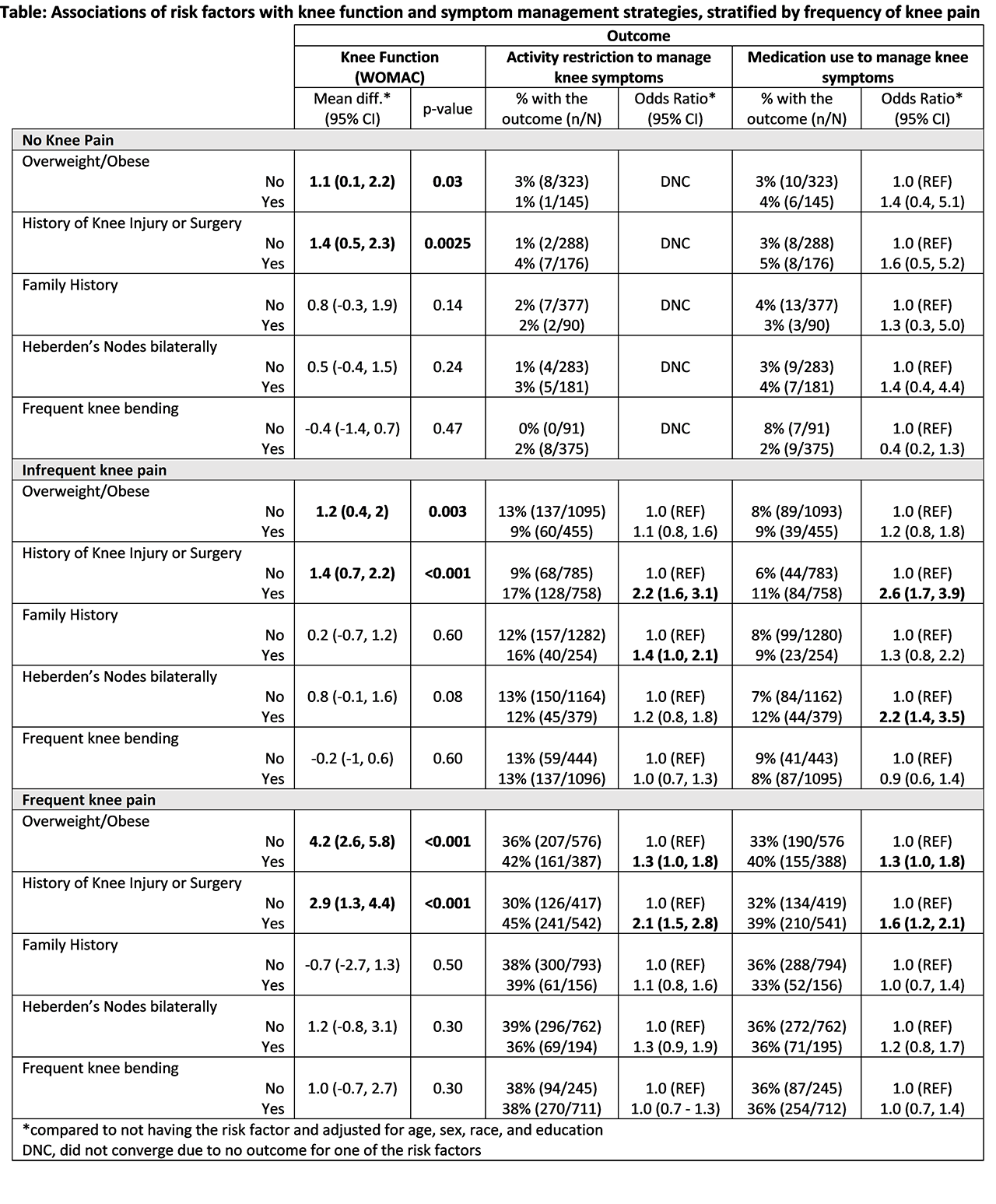Session Information
Date: Tuesday, November 12, 2019
Title: Epidemiology & Public Health Poster III: OA, Gout, & Other Diseases – ARP
Session Type: Poster Session (Tuesday)
Session Time: 9:00AM-11:00AM
Background/Purpose: Worse knee function and frequent use of knee symptom management strategies are common in people with symptomatic knee osteoarthritis (SxOA). There are several risk factors for SxOA, with the most common being overweight/obese (OW/OB) or having a previous knee injury/surgery (KISHx). Prior to the onset of SxOA, individuals likely are not seeking care, however the presence of risk factors may help identify those experiencing signs of early knee dysfunction and need for symptom management. Therefore, the purpose of this study was to describe the association of knee OA risk factors with knee function and symptom management. We stratified by frequency of knee pain since this is strongly related to knee function and use of symptom management strategies.
Methods: We used data from the Osteoarthritis Initiative (OAI). Our analytic sample was limited to those who had at least one risk factor for knee OA and were free of SxOA at baseline. Risk factors were: OW/OB as determined by age- and sex-specific cutoffs for weight, KISHx, family history (FmHx) of end-stage knee OA, presence of bilateral Heberden’s nodes, frequent knee bending, and knee symptoms in the past 12 months. Outcomes were obtained from self-report questionnaires, including: knee function via the WOMAC Physical Function score and symptom management strategies, i.e. activity limitation due to knee symptoms in the past 30 days (yes/no), use of medications in the past year due to knee symptoms (yes/no). To assess the associations of the risk factors with each outcome, we used a general linear model and logistic regression to calculate effect estimates/odds ratios with 95% confidence intervals (CI). Analyses were stratified by knee pain frequency and adjusted for potential confounders.
Results: Of the analytic sample (n=2987, age 61.1 ± 9.3 years old, 59% female, BMI 28.3 ± 4.7 kg/m2), 988 were OW/OB, 1475 had KISHx, 500 reported knee OA FmHx, 755 had bilateral Heberden’s nodes, and 2182 reported frequent knee bending. Regardless of frequency of knee pain, those who were OW/OB or with KISHx had significantly worse knee function than those without each risk factor (Table). In those with infrequent knee pain, KISHx was associated with use of both symptom management strategies, while FmHx was only associated with activity limitation and presence of bilateral Heberden’s nodes was only associated with use of medications. In individuals with frequent knee pain, OW/OB and KISHx were associated with use of both symptom management strategies.
Conclusion: KISHx and OW/OB were consistently associated with worse knee function regardless of the presence and frequency of knee pain. KISHx was also consistently associated with use of knee symptom management strategies when any knee pain was present, yet OW/OB was only associated in the presence of frequent knee pain. Other risk factors were not independently related to knee function, and inconsistently related to symptom management. These results emphasize the two most common risk factors for knee OA, OW/OB and KISHx, are also the most strongly related to knee function and symptom management. Early monitoring of people with these risk factors may allow for early intervention when symptoms present and delay the consequences of knee OA.
To cite this abstract in AMA style:
Jakiela J, White D, Master H, Christiansen M, Voinier D, Neely L, Thoma L. Understanding Knee Function and Symptom Management in Individuals with Risk Factors for Knee Osteoarthritis [abstract]. Arthritis Rheumatol. 2019; 71 (suppl 10). https://acrabstracts.org/abstract/understanding-knee-function-and-symptom-management-in-individuals-with-risk-factors-for-knee-osteoarthritis/. Accessed .« Back to 2019 ACR/ARP Annual Meeting
ACR Meeting Abstracts - https://acrabstracts.org/abstract/understanding-knee-function-and-symptom-management-in-individuals-with-risk-factors-for-knee-osteoarthritis/

